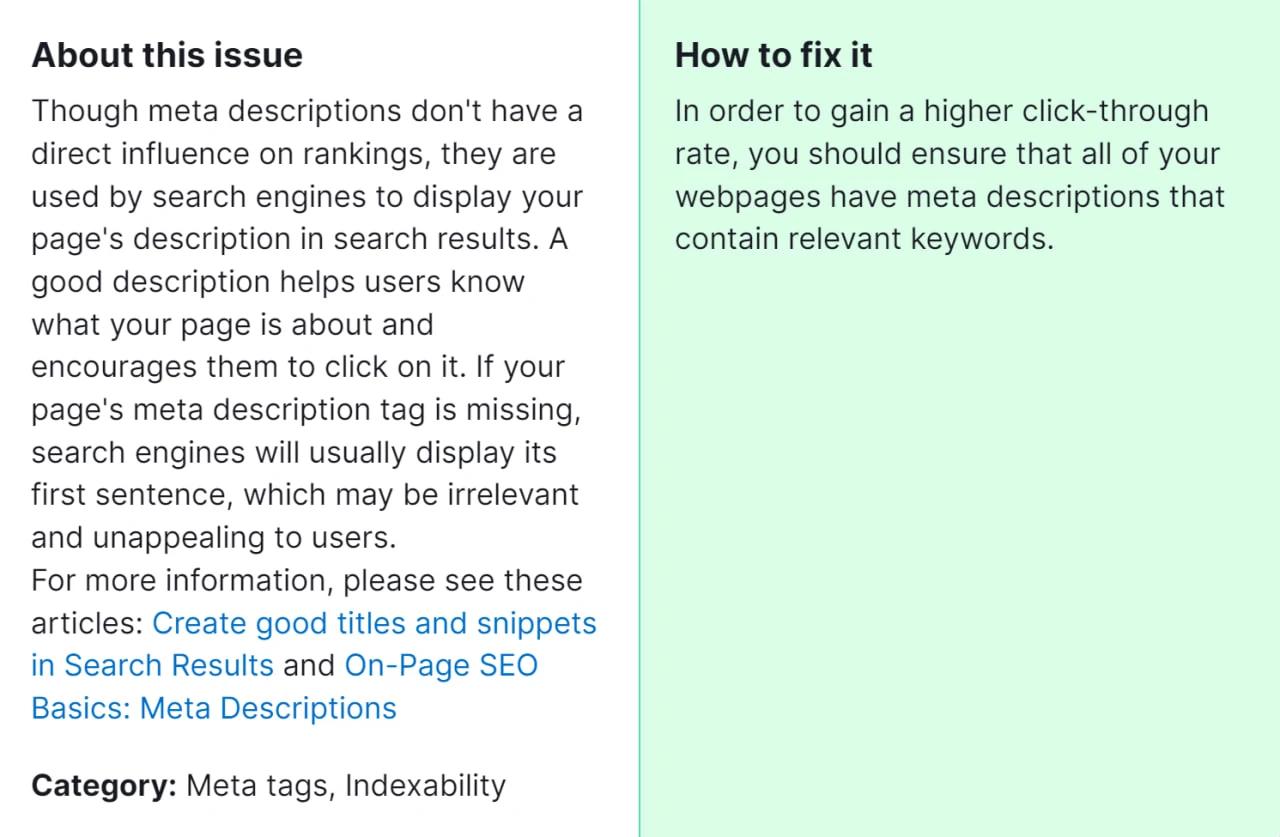When a website undergoes an SEO audit, one common issue that may arise is the absence of meta descriptions for its pages. Meta descriptions succinctly summarize web page content, aiding users in understanding its relevance before clicking. They serve as previews in search engine result pages (SERPs) and can significantly impact a website’s click-through rate and overall SEO performance.

Why is it important for you to fix this issue? Fixing the “Pages don’t have meta descriptions” error is crucial for enhancing your website’s search engine visibility and user experience. Without meta descriptions, search engines may generate their snippets from the page content, which might not accurately represent your content or entice users to click through to your site. By crafting unique and compelling meta descriptions for each page, you can improve your chances of attracting clicks and driving organic traffic.
How to Fix “Pages don’t have meta descriptions” Detected by a Semrush Audit

1. Identify Pages Lacking Meta Descriptions
Begin by accessing your Semrush audit report or dashboard. Look for the section that highlights pages without meta descriptions. This list will serve as your starting point for addressing the issue.
2. Prioritize Pages
Prioritize fixing meta descriptions for pages that are critical to your website’s goals, such as high-traffic pages, product/service pages, landing pages, and pages targeting important keywords.
3. Craft Unique and Descriptive Meta Descriptions
For each page lacking a meta description, create a unique and descriptive summary that accurately reflects the content of the page. Keep your descriptions concise (under 160 characters) and compelling to encourage clicks. Include pertinent keywords organically, steering clear of overloading with unnecessary terms, ensuring a natural flow and readability.
4. Use Actionable Language
Include actionable language or calls-to-action (CTAs) in your meta descriptions to prompt users to engage with your content. Words such as “Explore,” “Uncover,” or “Browse” can entice users to click and engage with your content.
5. Ensure Relevance
Make sure that the meta description accurately represents the content of the page. Inaccurate or irrelevant descriptions may result in user discontent and higher bounce rates.
6. Optimize for Click-Through Rate (CTR)
Experiment with different messaging and formats to optimize your meta descriptions for higher click-through rates. A compelling meta description can significantly improve your page’s visibility in SERPs.
7. Implement Meta Descriptions
Once you’ve crafted meta descriptions for the identified pages, implement them directly into the HTML code of each respective page. Locate the <meta> tag within the <head> section of the HTML and add a meta description using the following format:
html
<meta name=”description” content=”Your meta description here”>
8. Update and Monitor
After adding meta descriptions to your pages, update your website’s sitemap and notify search engines of the changes. Monitor your website’s performance in search results to assess the impact of the updated meta descriptions on click-through rates and organic traffic.
9. Regular Review and Optimization
Make meta description optimization a regular part of your SEO strategy. Periodically review your website’s pages to ensure that meta descriptions remain relevant and effective. Continuously optimize your meta descriptions based on user feedback, search trends, and changes in your content.
If the above steps do not yield the desired results or if you encounter challenges along the way, seeking assistance from our SEO specialist can provide valuable insights and guidance. By collaborating with a seasoned professional, you can navigate complex SEO issues more efficiently and achieve optimal results for your website.




